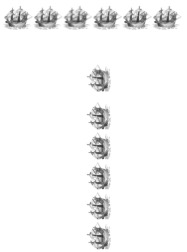Crossing the T: Battleship Strategy For Companies
 Before 150 years ago, naval warfare looked like two columns of ships (imagine an 11) blasting away at each other’s broadside with uniform damage and loss incurred on each side — like two equal-sized drunks in a bar brawl. Lots of carnage, and the one with the most ships, the most guns per ship, or the fastest reloads likely won.
Before 150 years ago, naval warfare looked like two columns of ships (imagine an 11) blasting away at each other’s broadside with uniform damage and loss incurred on each side — like two equal-sized drunks in a bar brawl. Lots of carnage, and the one with the most ships, the most guns per ship, or the fastest reloads likely won.
Whether by luck or design, fleets eventually employed a maneuver in which one would “cross the T” or meet the approaching vertical column by crossing in front of it (see the diagram below).
Here’s why this was effective. The fleet in the vertical line has a problem. Only the first ship can shoot freely at the enemy. The others are just going to blow up their mates. The fleet that has “crossed,” however, can fire all weapons at Ship 1 then 2 then 3, etc. It has at least six times the firepower.

Crossing the T
I can draw two business lessons from this military strategy. Perhaps you’ll have more.
First, organizations that keep tight control on mahogany row are like the ships in the vertical line. All the firepower resides with the top. Organizations that allow all their assets to engage in their business through collaboration, effective delegation and autonomy have much more firepower than the one that requires action of approval from the top.
Second, I’ve frequently worked with companies that wanted to move from a product-driven to a market-driven strategy. For instance, one of my clients addressed a specific market with a specific product. So did all the competition. Like naval warfare from 150 years ago, they lined up and shot lead at each other, and the one with the biggest marketing budget won.
Through asking the right questions, my client realized that it could better address this market’s needs with different products and services with multiple price points and value. It crossed the T by switching from “Want to buy a widget?” to “Let me better understand your needs and offer several solutions to meet them.” More artillery firing on the target.
How can you cross the T in your market?
My Top Three Observations This Week:
- As we loaded up our trailer to return home on our last camping trip from a national forest, a dozen cowboys and cowgirls drove a herd of about 200 free-range cattle across the access road right in front of our campsite. We couldn’t leave so we sat and watched. They joked, laughed and thoroughly enjoyed themselves as they adeptly moved the cows across a pasture. (The cow people were laughing, not the cows, who were no doubt heading to an early demise.) Competence in a job, whether CEO or cowgirl, makes it more fun!
- The board of directors at Wells Fargo is comprised of many talented people, yet the fraudulent account issue was apparently around for quite some time. I believe that boards too often avoid tough conversations and conflict. What do you think caused this issue to go on for so long?
- I admire Elon Musk, but I am starting to wonder if he is not in a bit of a “Ponzi-world”, having to sell a grander vision each month to keep his stockholders happy while he continues to lose money. This month we colonize Mars. Is Jupiter next?

coaches CEOs to higher levels of success. He is a former CEO and has led teams as large as 7,000 people. Todd is the author of, Never Kick a Cow Chip On A Hot Day: Real Lessons for Real CEOs and Those Who Want To Be (Morgan James Publishing).
Connect with Todd on LinkedIn, Twitter, call 303-527-0417 or email [email protected].

Lisa Hamaker
2:15 pm September 27, 2016Great post Todd, as always. I have long based my marketing and business strategies on customers, not against the competition. This brings that concept to a more strategic level, and gives me some great language to put it to use and share it with others. Thanks! Lisa
Todd Ordal
2:24 pm September 27, 2016Thanks, Lisa. I agree with your approach. You certainly must understand your competitive environment, but in business if you are are always focused on your competitors, you’ll usually end up playing catch-up. The essence of strategy is being different, not just slightly better. In terms of the blog, rather than, How can we put one more gun on the ship?, crossing the T answered the question, “How can we change the nature of the battle?”